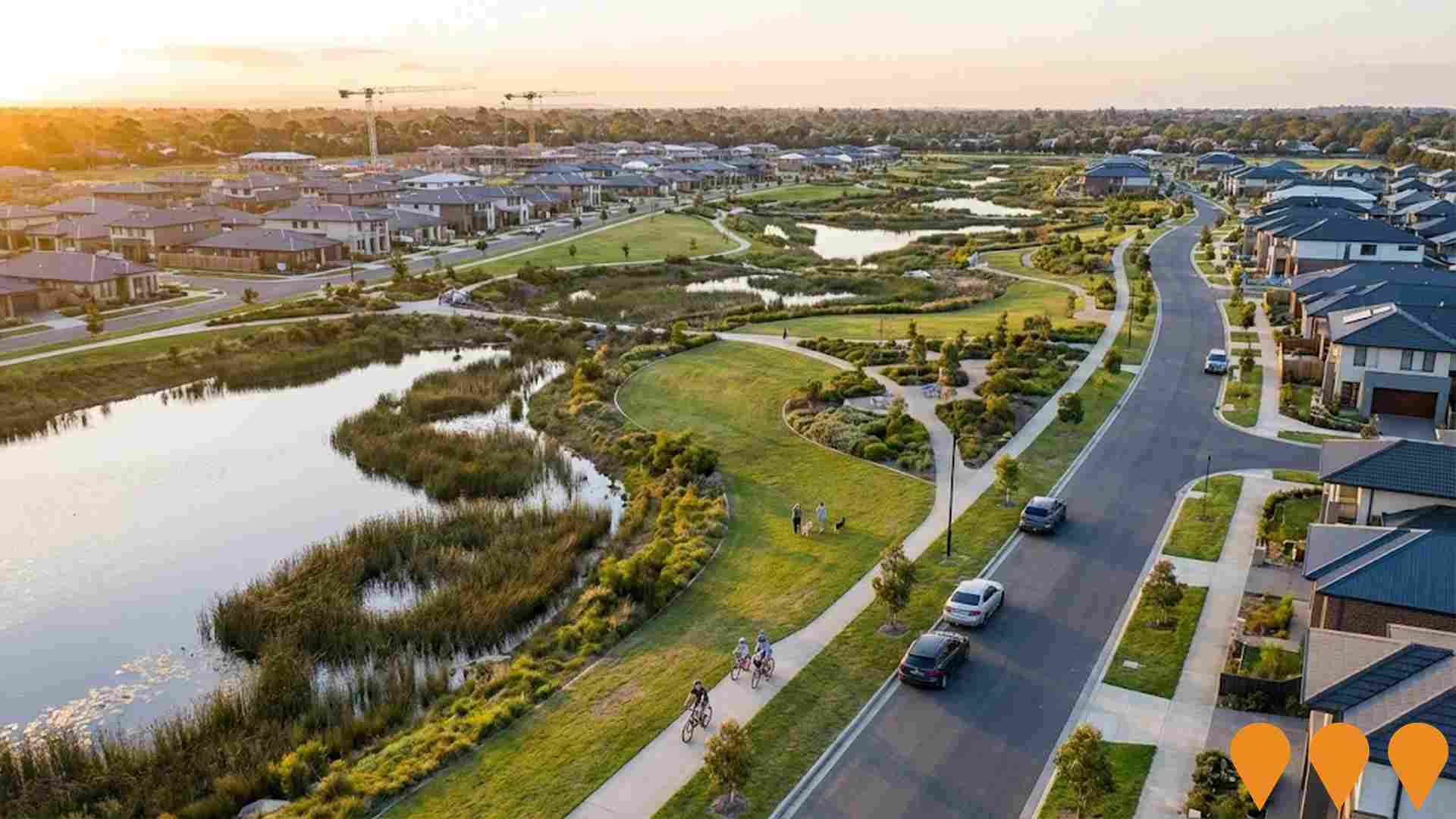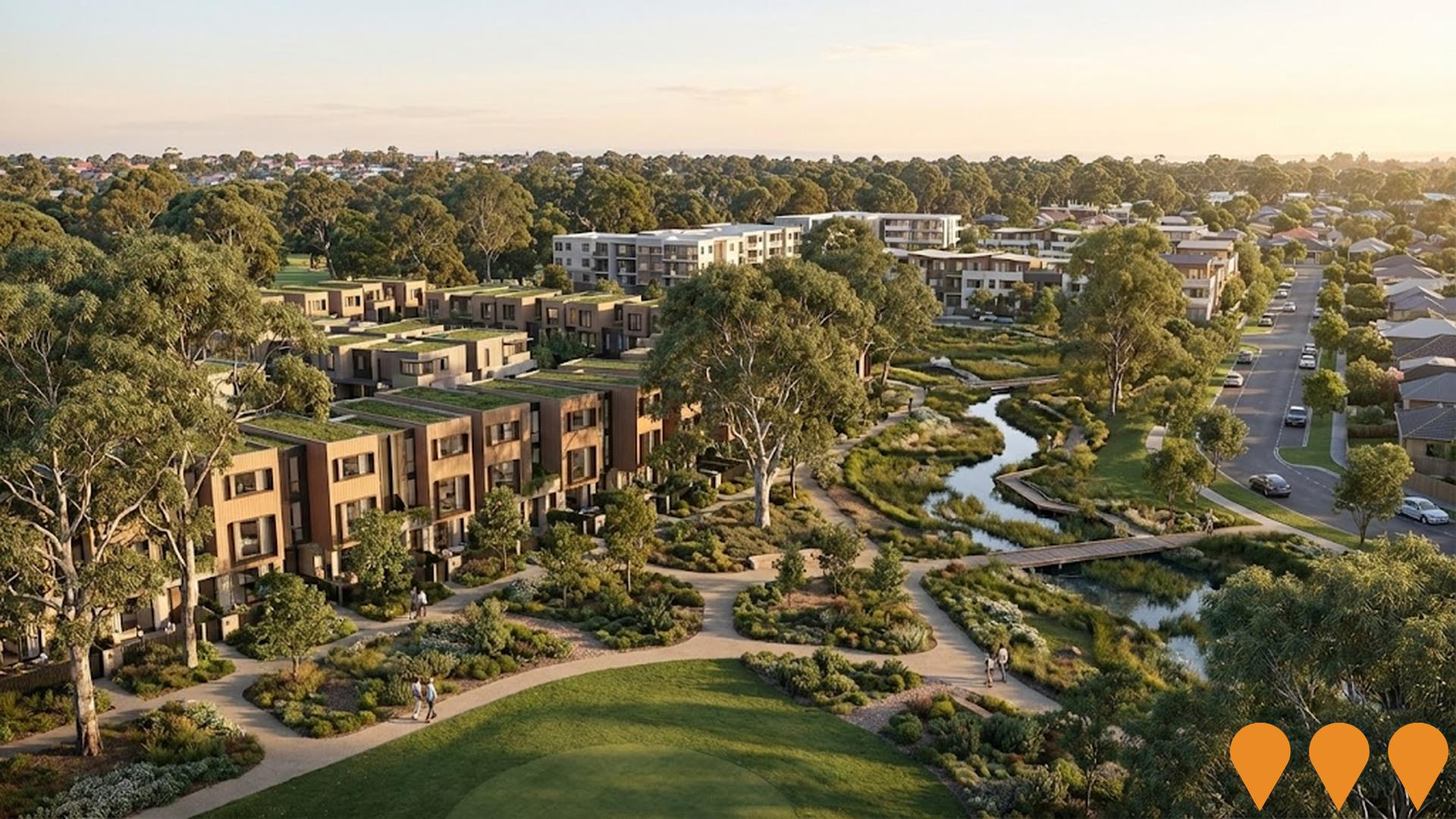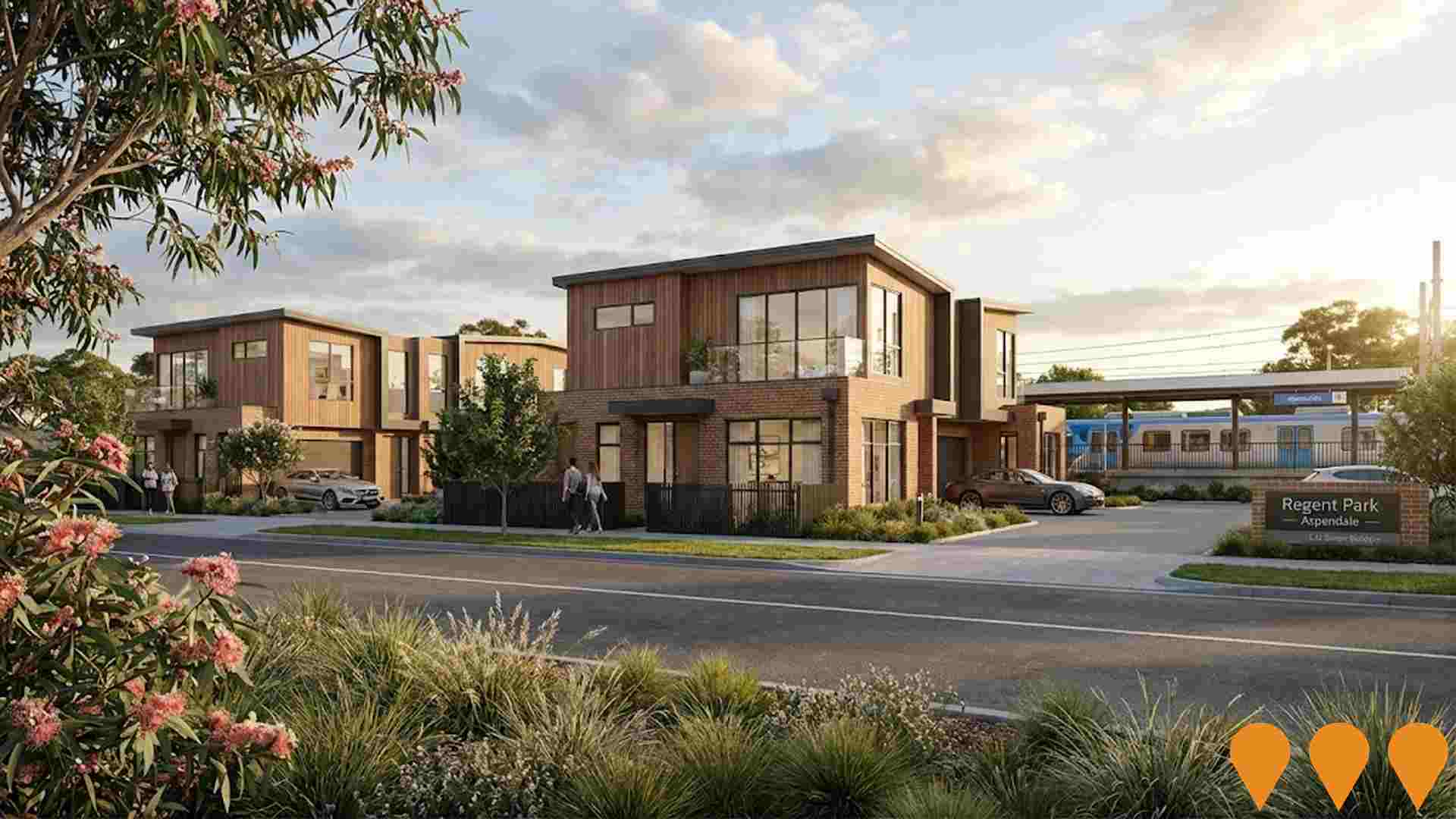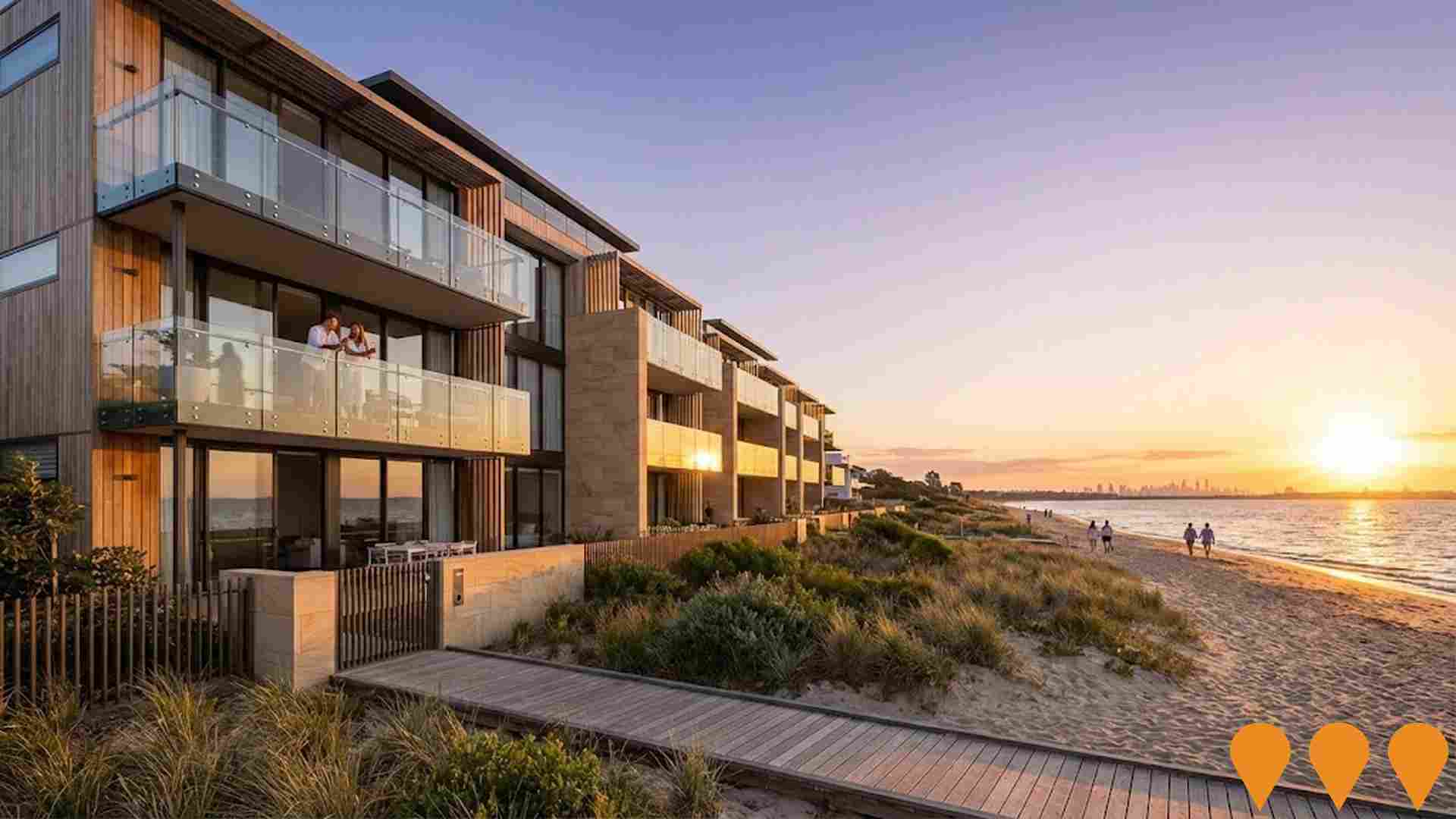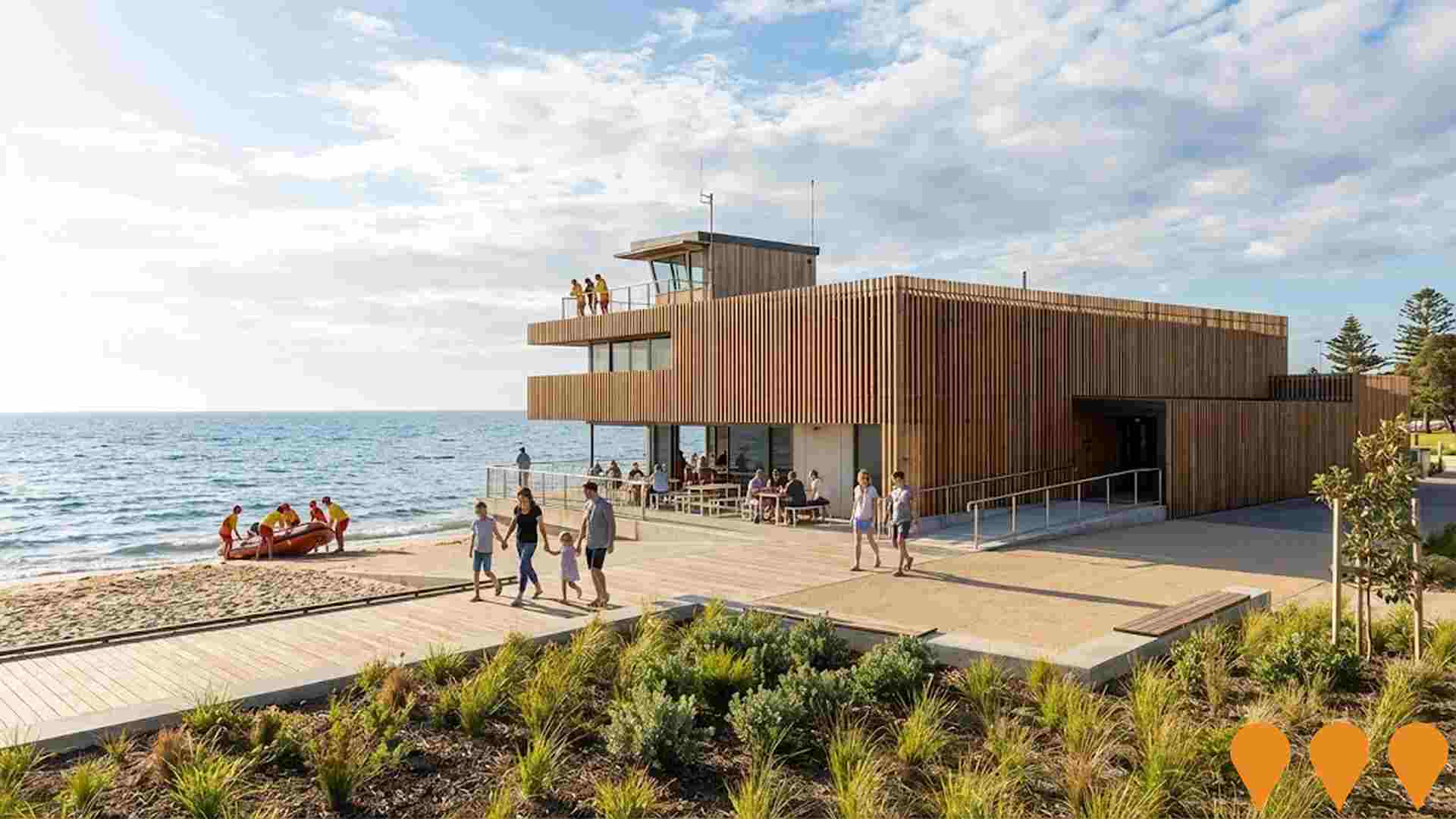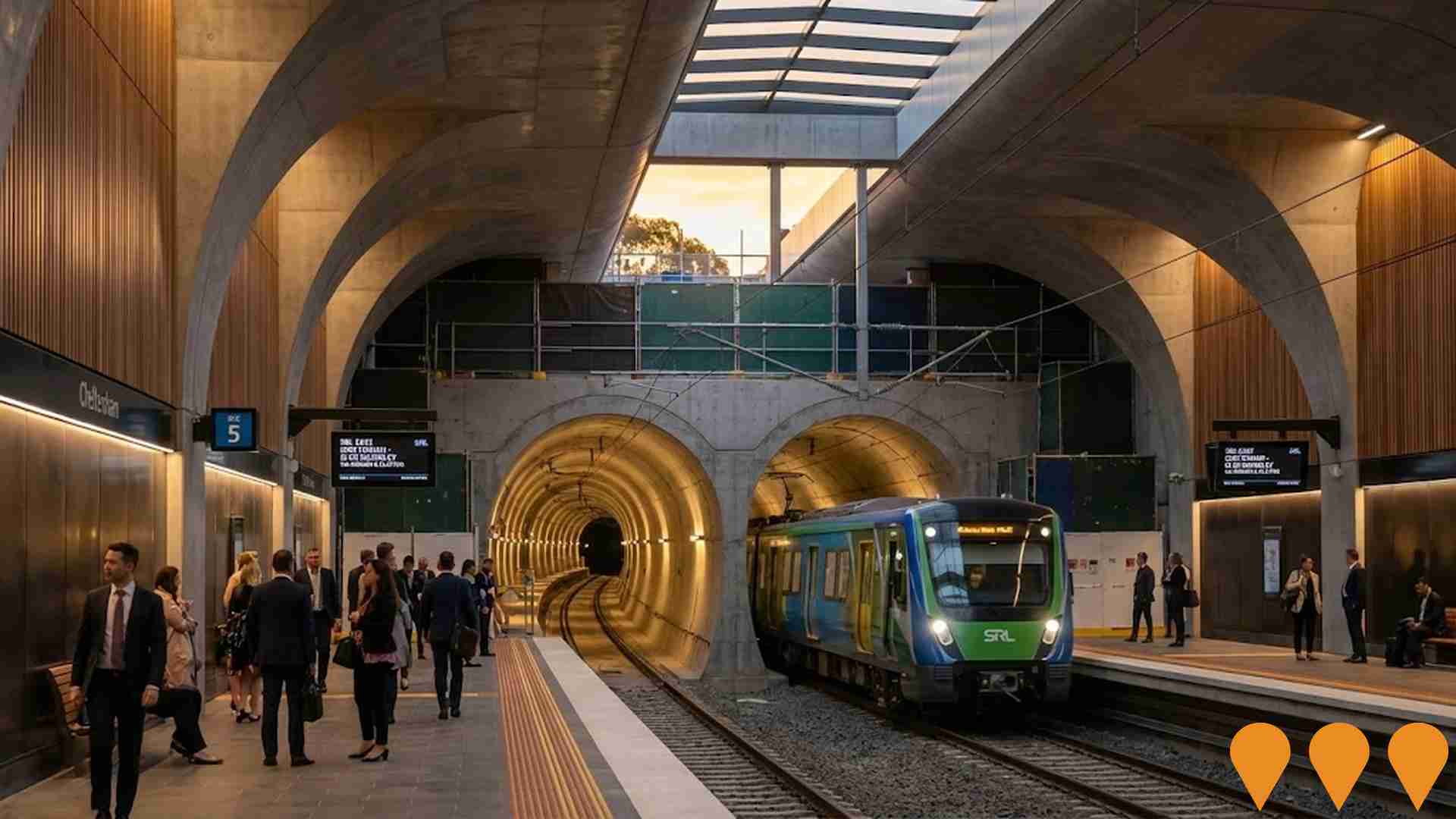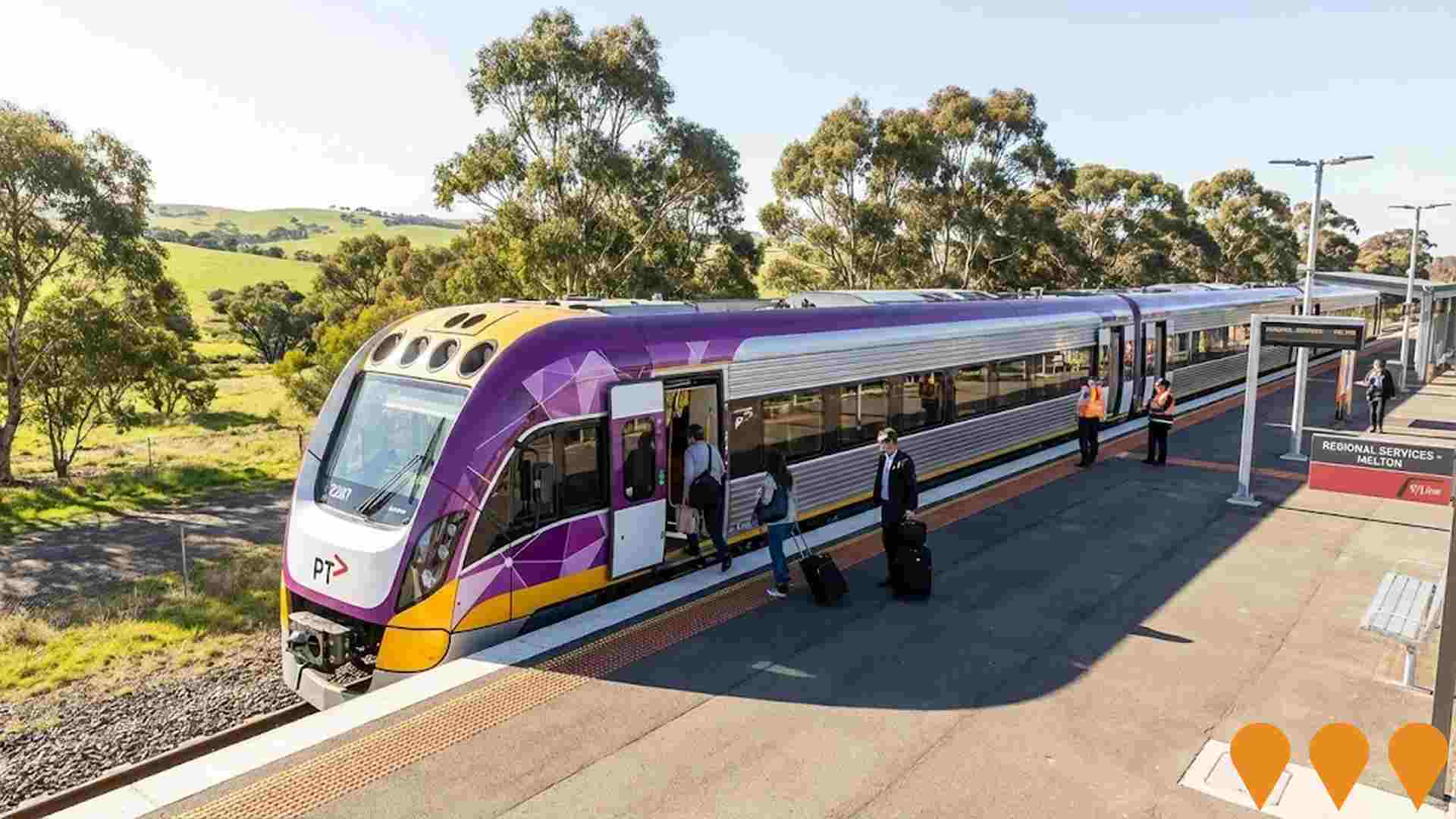Chart Color Schemes
est. as @ -- *
ABS ERP | -- people | --
2021 Census | -- people
Sales Activity
Curious about local property values? Filter the chart to assess the volume and appreciation (including resales) trends and regional comparisons, or scroll to the map below view this information at an individual property level.
Find a Recent Sale
Sales Detail
Population
Aspendale Gardens - Waterways is positioned among the lower quartile of areas assessed nationally for population growth based on AreaSearch's assessment of recent, and medium term trends
Aspendale Gardens - Waterways' population, as per AreaSearch's analysis, was around 9,099 by Nov 2025. This figure shows an increase of 246 people since the 2021 Census, which recorded a population of 8,853. The growth is inferred from ABS' estimated resident population of 9,099 in Jun 2024 and seven additional validated new addresses post-census. This results in a density ratio of 1,713 persons per square kilometer, higher than the average seen across national locations assessed by AreaSearch. The area's 2.8% growth since census is within 2.9 percentage points of its SA3 area (5.7%), indicating competitive growth fundamentals. Overseas migration contributed approximately 87.2% of overall population gains during recent periods, driving primary growth in the area.
AreaSearch adopts ABS/Geoscience Australia projections for each SA2 area, released in 2024 with a base year of 2022. For areas not covered by this data, AreaSearch uses VIC State Government's Regional/LGA projections from 2023, adjusted employing weighted aggregation methods to SA2 levels. Growth rates by age group are applied across all areas for years 2032 to 2041. Future population dynamics project an above median growth for statistical areas nationally, with Aspendale Gardens - Waterways expected to expand by 1,114 persons to 2041, recording a total gain of 12.2% over the 17 years.
Frequently Asked Questions - Population
Development
The level of residential development activity in Aspendale Gardens - Waterways is very low in comparison to the average area assessed nationally by AreaSearch
Aspendale Gardens - Waterways has recorded approximately 4 residential properties granted approval annually. Over the past five financial years, from FY21 to FY25, around 23 homes have been approved, with one more granted in FY26 so far. The population decline in recent years has maintained adequate housing supply relative to demand, resulting in a balanced market with good buyer choice.
New properties are constructed at an average expected cost of $646,000, indicating a focus on the premium segment with upmarket dwellings. In this financial year, commercial development approvals totaled $13.7 million, showing moderate levels of commercial activity. Compared to Greater Melbourne, Aspendale Gardens - Waterways has significantly less development activity, at 91.0% below the regional average per person. This scarcity typically strengthens demand and prices for existing properties. Recent development has been exclusively detached houses, sustaining the area's suburban identity with a concentration of family homes suited to buyers seeking space.
The location currently has approximately 5451 people per dwelling approval, indicating an established market. Future projections show Aspendale Gardens - Waterways adding around 1,114 residents by 2041. At current development rates, housing supply may struggle to match population growth, potentially increasing buyer competition and supporting price increases.
Frequently Asked Questions - Development
Infrastructure
Aspendale Gardens - Waterways has very high levels of nearby infrastructure activity, ranking in the top 20% nationally
Five projects identified by AreaSearch are expected to impact the area significantly. These include Aspendale Gardens Shopping Centre Redevelopment, Rossdale Golf Course Redevelopment in Aspendale, The Strand Aspendale, and Dingley Village (former Kingswood Golf Course).
Professional plan users can use the search below to filter and access additional projects.
INFRASTRUCTURE SEARCH
 Denotes AI-based impression for illustrative purposes only, not to be taken as definitive under any circumstances. Please follow links and conduct other investigations from the project's source for actual imagery. Developers and project owners wishing us to use original imagery please Contact Us and we will do so.
Denotes AI-based impression for illustrative purposes only, not to be taken as definitive under any circumstances. Please follow links and conduct other investigations from the project's source for actual imagery. Developers and project owners wishing us to use original imagery please Contact Us and we will do so.
Frequently Asked Questions - Infrastructure
Level Crossing Removal - Caulfield to Dandenong
Major infrastructure project removing 9 level crossings by elevating the railway line between Caulfield and Dandenong on the Cranbourne-Pakenham corridor. Includes complete redevelopment of 5 elevated stations (Carnegie, Murrumbeena, Hughesdale, Clayton, and Noble Park) with modern facilities, improved accessibility, and integration with new public open space (22.5 hectares of parkland). Delivered as a single $1.6-2.4 billion package, significantly improving safety, reducing congestion, and enabling more train services.
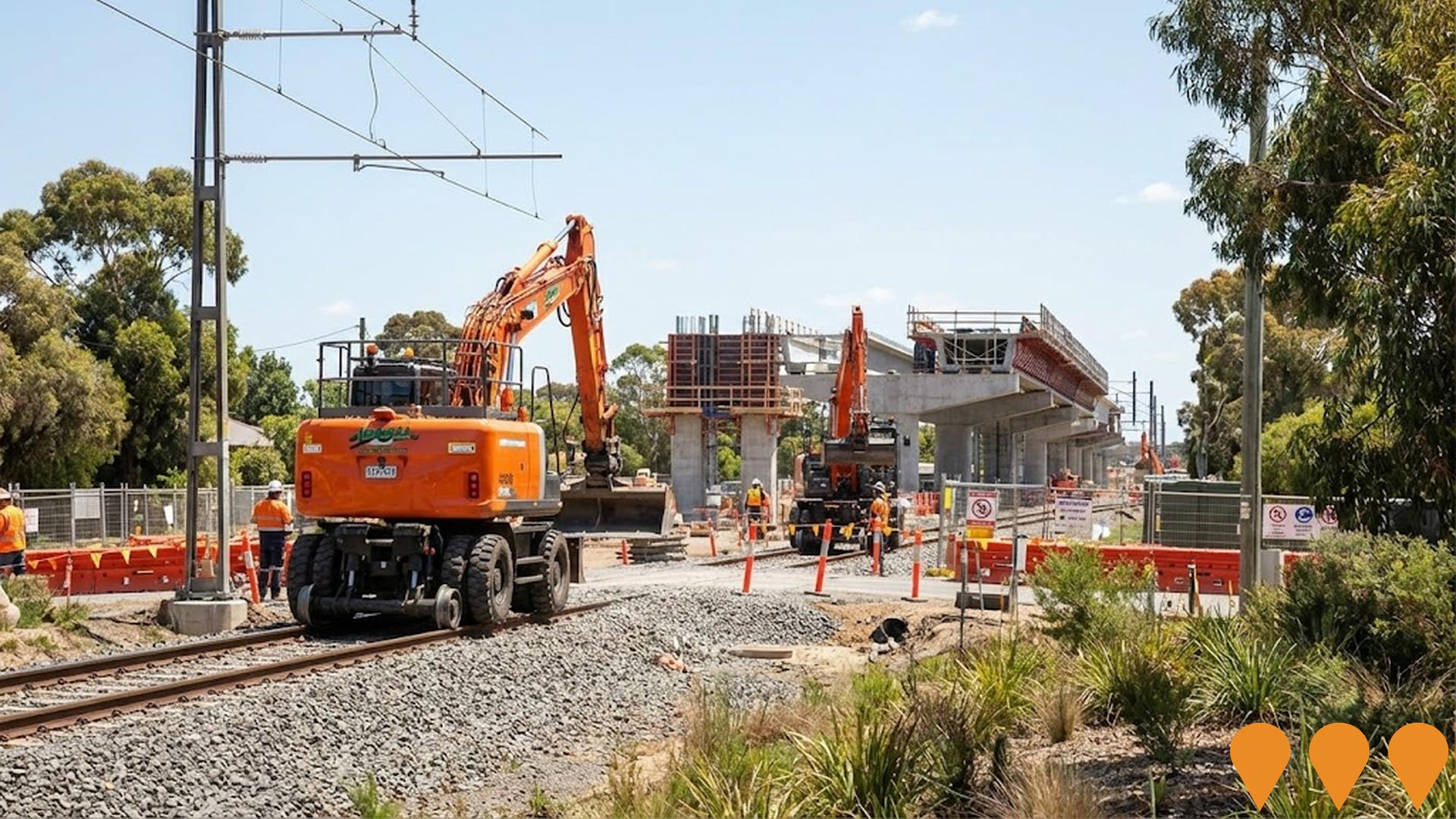
Monash Freeway Upgrade Stage 2
Major $1.4 billion freeway upgrade adding 36km of new lanes between Warrigal Road and Cardinia Road. Includes upgraded Beaconsfield interchange with new diamond configuration, Police Road connection, Jackson Road direct link to EastLink, O'Shea Road extension and widening, smart lane management systems, and shared cycling paths. Completed end of 2022, reducing travel times by up to 9 minutes during peak hours for 470,000 daily users.

Frankston Line Level Crossing Removal Program
Victorian Government program to remove all 27 remaining level crossings on the Frankston Line by 2029, delivering a boom-gate-free corridor from Caulfield to Frankston. The project includes rebuilding 19 stations, major rail trench and elevated rail sections, new and upgraded stations at Cheltenham, Mentone, Mordialloc, Aspendale, Seaford and Frankston, plus extensive open space creation and active transport links. As of December 2025, 20 of the 27 crossings have been removed, with major works continuing at Mentone, Cheltenham, Bonbeach and Carrum, and planning advancing for the final stages toward Frankston.
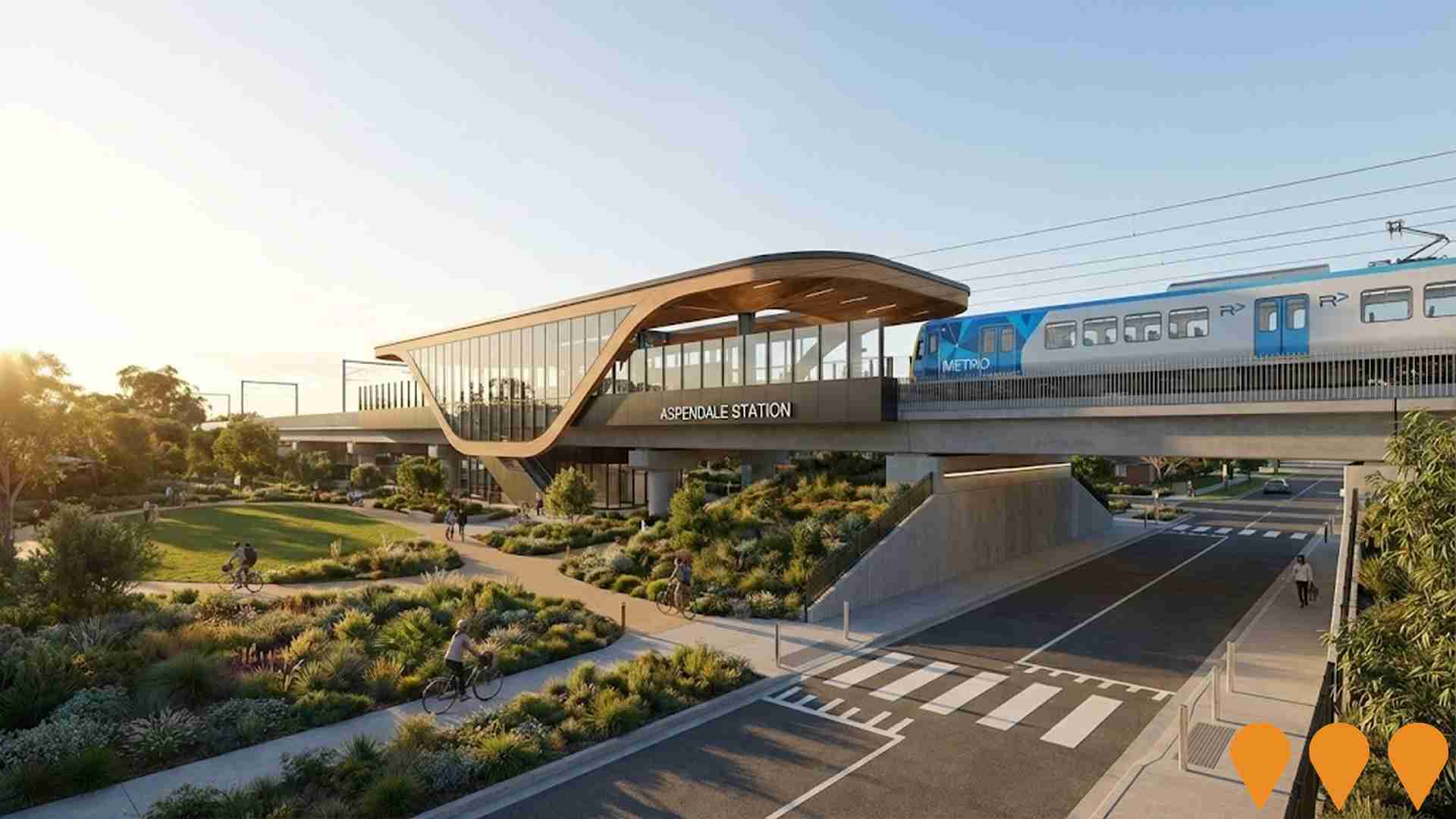
Mordi Aquatic Centre
New state-of-the-art aquatic and leisure centre in Mordialloc delivering a 50m outdoor pool, indoor 25m pool, learn-to-swim pool, warm water program pool, splash park, gym, spa, sauna, steam room and cafe. Jointly funded by City of Kingston and the Australian Government ($20m contribution). ADCO Constructions is the appointed builder, CO.OP Studio the architect. Construction commenced in 2024 and is scheduled for completion in late 2026.
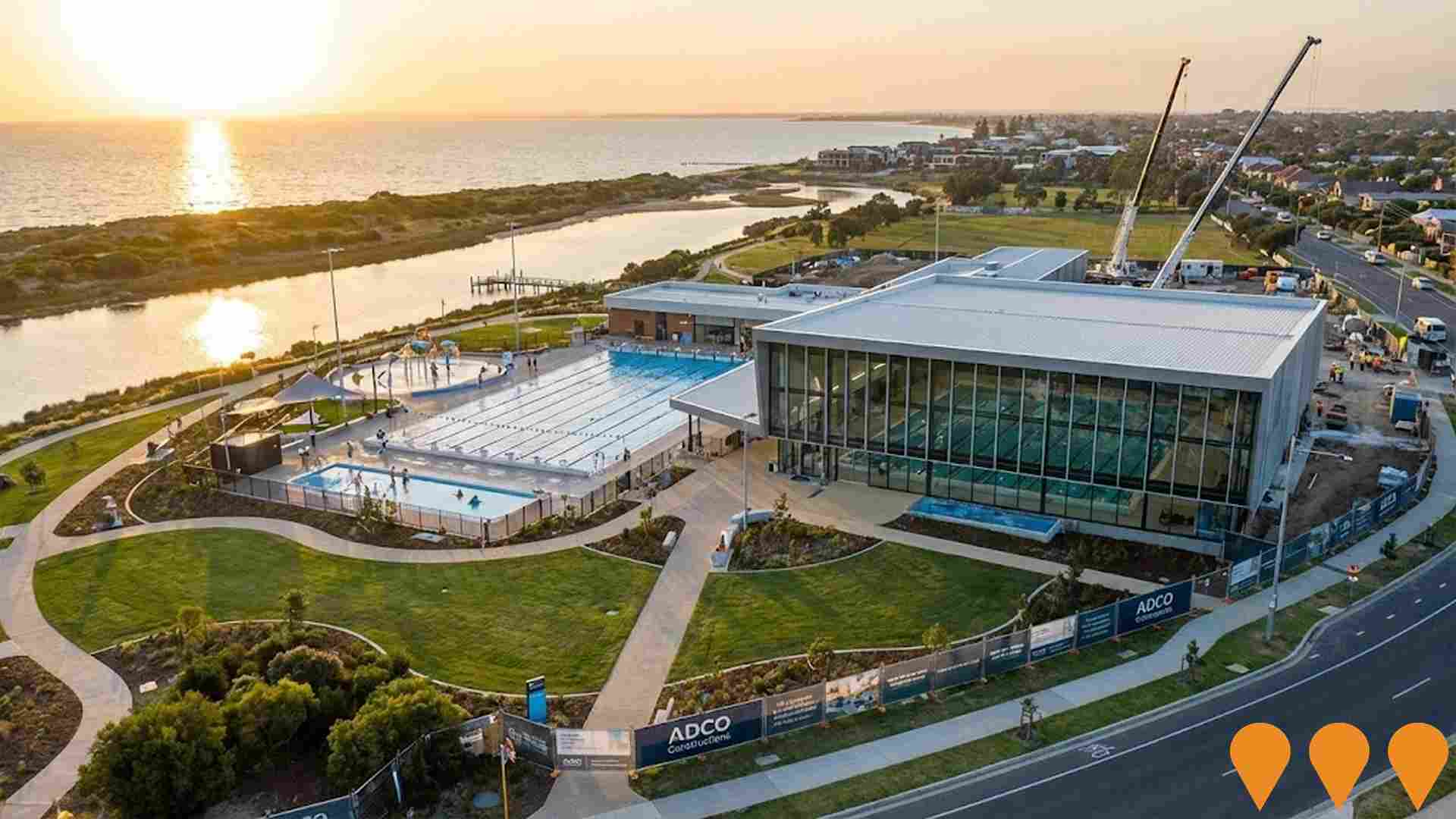
EastLink Freeway Noble Park Section
39km tollway connecting the Eastern and Mornington Peninsula Freeways, featuring innovative design with the railway line running in the freeway median through Noble Park. Operated by ConnectEast, owned by Horizon Roads consortium. The freeway serves approximately 250,000 vehicles daily and includes two 1.6km tunnels protecting the Mullum Mullum valley.

Aspendale Gardens Shopping Centre Redevelopment
Proposed expansion and modernisation of Aspendale Gardens Shopping Centre, which includes a Ritchies Supa IGA and approximately 17 specialty stores. The redevelopment may involve the development of a top floor of approximately 3700 sq. metres. Community discussion in 2021 noted concerns about a new proposed shopping center being approved near existing gambling venues. The shopping centre offers exposure to approximately 30,000 visitors weekly.

Mordialloc Activity Centre - Pride of the Bay Structure Plan and Village Masterplan
Council led long term renewal of the Mordialloc Major Activity Centre guided by the "Mordialloc Pride of the Bay" structure plan adopted in 2004 and now flagged for review. The plan sets a 20 year plus vision for higher density mixed use development around Mordialloc Station, Main Street and the creek and foreshore, including shop top and apartment housing, upgraded streetscapes, better pedestrian and cycling links, public spaces and protection of key coastal and heritage views. Current strategic work focuses on aligning future built form and public realm upgrades with the Victorian Government level crossing removal program and a new elevated station precinct before a refreshed structure plan and controls are prepared.

Aspendale Beachside Structure Plan
Council-led **Structure Plan** (long-term vision) to guide growth and change in the Aspendale beachfront activity centre. The plan provides ideals for future land use and development, including mixed-use development, public realm upgrades, and improved foreshore connections to meet future community needs. It is supported by Council policy for increased housing diversity in the precinct.
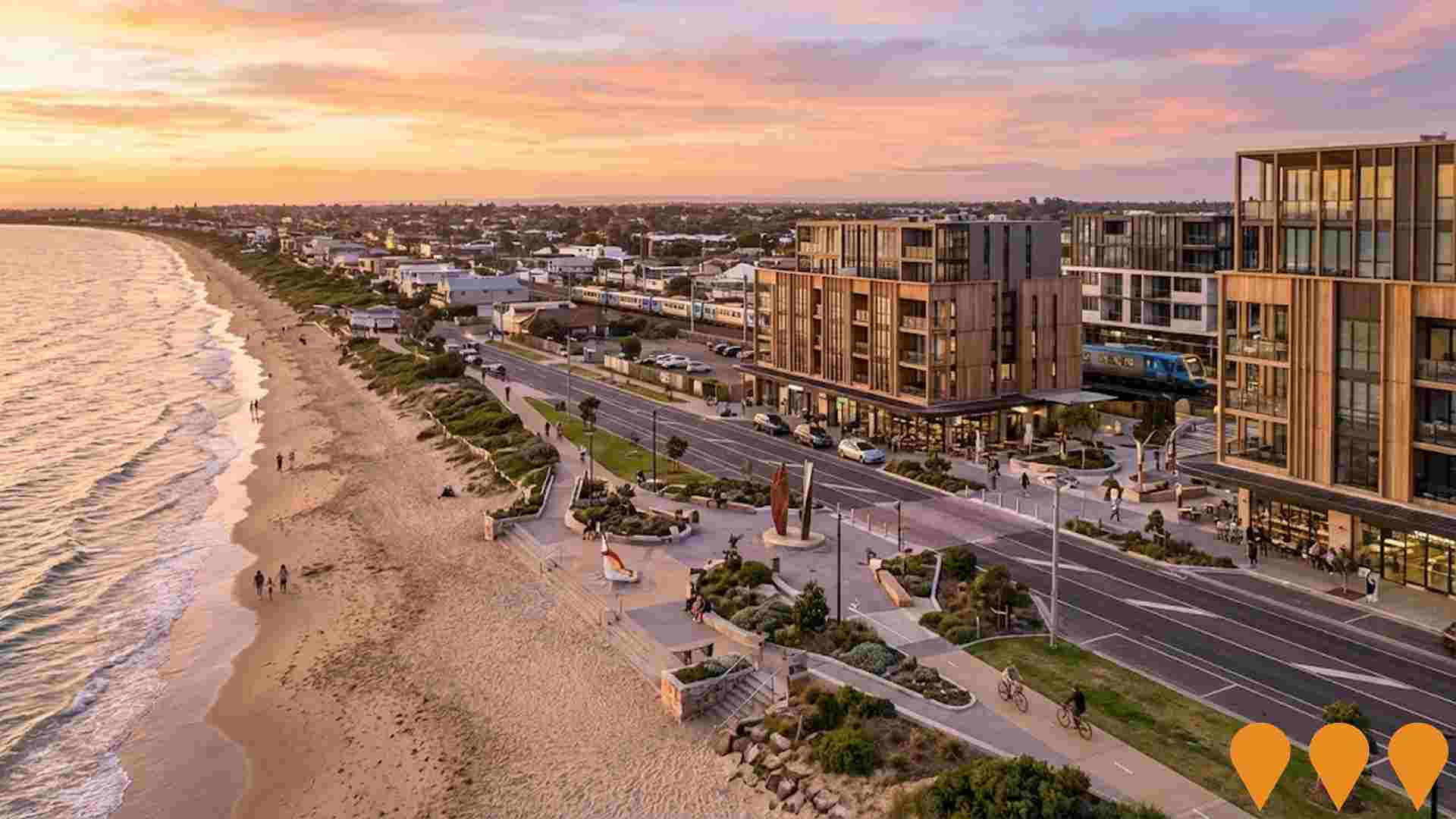
Employment
Employment performance in Aspendale Gardens - Waterways has been broadly consistent with national averages
Aspendale Gardens - Waterways has an educated workforce with strong professional services representation. Its unemployment rate was 3.5% as of June 2024.
In comparison, Greater Melbourne's unemployment rate was 4.6%. Workforce participation in Aspendale Gardens - Waterways was 68.2%, slightly higher than Greater Melbourne's 64.1%. Key employment industries include health care & social assistance, retail trade, and manufacturing. Retail trade is particularly prominent, with an employment share of 1.3 times the regional level.
However, professional & technical services are under-represented at 8.1%, compared to 10.1% in Greater Melbourne. The area appears to have limited local employment opportunities based on Census data comparisons. Between June 2024 and June 2025, Aspendale Gardens - Waterways' labour force increased by 1.5%, while employment declined by 0.1%, causing unemployment to rise by 1.5 percentage points. In contrast, Greater Melbourne saw employment growth of 3.5% and a smaller increase in unemployment. Jobs and Skills Australia's national employment forecasts from May 2025 project national employment growth of 6.6% over five years and 13.7% over ten years. Applying these projections to Aspendale Gardens - Waterways' employment mix suggests local growth of approximately 6.3% over five years and 13.2% over ten years, though these are simple extrapolations for illustrative purposes only.
Frequently Asked Questions - Employment
Income
The area exhibits notably strong income performance, ranking higher than 70% of areas assessed nationally through AreaSearch analysis
AreaSearch's latest postcode level ATO data for financial year 2022 indicates that income in Aspendale Gardens - Waterways is very high nationally. The median income is assessed at $54,281 while the average income stands at $72,411. This contrasts with Greater Melbourne's figures of a median income of $54,892 and an average income of $73,761. Based on Wage Price Index growth of 12.16% since financial year 2022, current estimates would be approximately $60,882 (median) and $81,216 (average) as of September 2025. From the 2021 Census, household incomes rank exceptionally at the 86th percentile ($2,348 weekly), though personal income ranks lower at the 59th percentile. Income analysis reveals that the $1,500 - 2,999 earnings band captures 32.6% of the community (2,966 individuals), consistent with broader trends across the region showing 32.8% in the same category. The substantial proportion of high earners (37.0% above $3,000/week) indicates strong economic capacity throughout Aspendale Gardens - Waterways. After housing costs, residents retain 87.1% of income, reflecting strong purchasing power and the area's SEIFA income ranking places it in the 8th decile.
Frequently Asked Questions - Income
Housing
Aspendale Gardens - Waterways is characterized by a predominantly suburban housing profile, with above-average rates of outright home ownership
Aspendale Gardens - Waterways had 85.3% houses and 14.6% other dwellings in the latest Census, compared to Melbourne metro's 54.8% houses and 45.2% other dwellings. Home ownership in Aspendale Gardens - Waterways was 38.6%, with mortgaged dwellings at 50.3% and rented ones at 11.2%. The median monthly mortgage repayment was $2,115, below Melbourne metro's average of $2,167. Median weekly rent in Aspendale Gardens - Waterways was $510, compared to Melbourne metro's $410. Nationally, Aspendale Gardens - Waterways had higher mortgage repayments at $2,115 versus the Australian average of $1,863 and higher rents at $510 compared to the national figure of $375.
Frequently Asked Questions - Housing
Household Composition
Aspendale Gardens - Waterways features high concentrations of family households, with a higher-than-average median household size
Family households account for 85.5% of all households, including 51.8% that are couples with children, 23.4% that are couples without children, and 9.4% that are single parent families. Non-family households make up the remaining 14.5%, with lone person households at 13.9% and group households comprising 0.8%. The median household size is 3.0 people, larger than the Greater Melbourne average of 2.4.
Frequently Asked Questions - Households
Local Schools & Education
Aspendale Gardens - Waterways shows strong educational performance, ranking in the upper quartile nationally when assessed across multiple qualification and achievement indicators
The area faces educational challenges, with university qualification rates at 31.9%, significantly below the SA4 region average of 46.0%. This presents both a challenge and an opportunity for targeted educational initiatives. Bachelor degrees are the most common, held by 22.0% of residents, followed by postgraduate qualifications (7.1%) and graduate diplomas (2.8%). Trade and technical skills are prominent, with 29.5% of residents aged 15+ holding vocational credentials – advanced diplomas (11.8%) and certificates (17.7%).
Educational participation is high, with 30.7% of residents currently enrolled in formal education. This includes secondary education (9.7%), primary education (9.6%), and tertiary education (5.9%). Aspendale Gardens Primary School serves the area, with an enrollment of 604 students as of a recent report. The school focuses exclusively on primary education, with secondary options available in surrounding areas from 2015 onwards. Limited local school capacity (6.6 places per 100 residents vs regional average of 15.7) means many families travel to nearby areas for schooling since 2015.
Frequently Asked Questions - Education
Schools Detail
Nearby Services & Amenities
Transport
Transport servicing is moderate compared to other areas nationally based on assessment of service frequency, route connectivity and accessibility
Analysis shows 23 active public transport stops in Aspendale Gardens - Waterways, all bus stops. These are served by 8 different routes, offering a total of 1910 weekly passenger trips. Transport access is rated good, with residents on average 245 meters from the nearest stop.
Services run an average of 272 trips per day across all routes, equating to about 83 weekly trips per stop.
Frequently Asked Questions - Transport
Transport Stops Detail
Health
Aspendale Gardens - Waterways's residents are extremely healthy with younger cohorts in particular seeing very low prevalence of common health conditions
Analysis of health metrics shows strong performance throughout Aspendale Gardens - Waterways, with younger cohorts seeing very low prevalence of common health conditions. The rate of private health cover is very high at approximately 55% of the total population (~5,031 people), compared to 58.2% across Greater Melbourne.
The most common medical conditions in the area are asthma and arthritis, impacting 6.9 and 6.2% of residents respectively, while 74.2% declared themselves completely clear of medical ailments, compared to 70.4% across Greater Melbourne. The area has 18.2% of residents aged 65 and over (1,652 people), which is lower than the 19.3% in Greater Melbourne. Health outcomes among seniors are above average but require more attention than the broader population.
Frequently Asked Questions - Health
Cultural Diversity
Aspendale Gardens - Waterways is among the most culturally diverse areas in the country based on AreaSearch assessment of a range of language and cultural background related metrics
Aspendale Gardens-Waterways has a high cultural diversity, with 35.7% of its population born overseas and 32.3% speaking a language other than English at home. Christianity is the predominant religion in Aspendale Gardens-Waterays, comprising 50.9% of the population. However, Judaism is overrepresented compared to Greater Melbourne, making up 0.7% versus 1.1%.
The top three ancestry groups are English (20.2%), Australian (19.3%), and Other (12.6%). Sri Lankan, Greek, and Polish ethnicities are notably more represented in Aspendale Gardens-Waterways compared to the regional averages.
Frequently Asked Questions - Diversity
Age
Aspendale Gardens - Waterways hosts an older demographic, ranking in the top quartile nationwide
The median age in Aspendale Gardens - Waterways is 42 years, significantly higher than Greater Melbourne's average of 37 years and Australia's median age of 38 years. The 55-64 age group makes up 15.6% of the population, compared to Greater Melbourne, while the 25-34 cohort represents 8.1%. According to post-2021 Census data, the 55 to 64 age group has increased from 13.9% to 15.6%, and the 75 to 84 cohort has risen from 5.1% to 6.2%. Conversely, the 45 to 54 cohort has decreased from 17.5% to 15.3%, and the 5 to 14 age group has dropped from 13.7% to 12.2%. Population forecasts for 2041 indicate substantial demographic changes in Aspendale Gardens - Waterways, with the 65 to 74 group expected to grow by 49%, reaching 1,255 people from 844. The combined age groups of 65 and above will account for 82% of total population growth, reflecting the area's aging demographic profile. In contrast, the 0 to 4 and 15 to 24 cohorts are projected to experience population declines.
